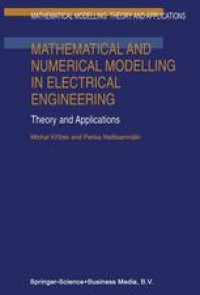
Ebook: Mathematical and Numerical Modelling in Electrical Engineering Theory and Applications
- Genre: Technique // Electronics: Electronics
- Tags: Computational Mathematics and Numerical Analysis, Partial Differential Equations, Mathematical Modeling and Industrial Mathematics, Functional Analysis, Applications of Mathematics
- Series: Mathematical Modelling: Theory and Applications 1
- Year: 1996
- Publisher: Springer Netherlands
- Edition: 1
- Language: English
- pdf
Mathematical modeling plays an essential role in science and engineering. Costly and time consuming experiments (if they can be done at all) are replaced by computational analysis. In industry, commercial codes are widely used. They are flexible and can be adjusted for solving specific problems of interest. Solving large problems with tens or hundreds of thousands unknowns becomes routine. The aim of analysis is to predict the behavior of the engineering and physical reality usually within the constraints of cost and time. Today, human cost and time are more important than computer cost. This trend will continue in the future. Agreement between computational results and reality is related to two factors, namely mathematical formulation of the problems and the accuracy of the numerical solution. The accuracy has to be understood in the context of the aim of the analysis. A small error in an inappropriate norm does not necessarily mean that the computed results are usable for practical purposes.
The main aim of this book is twofold. Firstly, it shows engineers why it is useful to deal with, for example, Hilbert spaces, imbedding theorems, weak convergence, monotone operators, compact sets, when solving real-life technical problems. Secondly, mathematicians will see the importance and necessity of dealing with material anisotropy, inhomogeneity, nonlinearity and complicated geometrical configurations of electrical devices, which are not encountered when solving academic examples with the Laplace operator on square or ball domains.
Mathematical and numerical analysis of several important technical problems arising in electrical engineering are offered, such as computation of magnetic and electric field, nonlinear heat conduction and heat radiation, semiconductor equations, Maxwell equations and optimal shape design of electrical devices.
The reader is assumed to be familiar with linear algebra, real analysis and basic numerical methods.
Audience: This volume will be of interest to mathematicians and engineers whose work involves numerical analysis, partial differential equations, mathematical modelling and industrial mathematics, or functional analysis.
The main aim of this book is twofold. Firstly, it shows engineers why it is useful to deal with, for example, Hilbert spaces, imbedding theorems, weak convergence, monotone operators, compact sets, when solving real-life technical problems. Secondly, mathematicians will see the importance and necessity of dealing with material anisotropy, inhomogeneity, nonlinearity and complicated geometrical configurations of electrical devices, which are not encountered when solving academic examples with the Laplace operator on square or ball domains.
Mathematical and numerical analysis of several important technical problems arising in electrical engineering are offered, such as computation of magnetic and electric field, nonlinear heat conduction and heat radiation, semiconductor equations, Maxwell equations and optimal shape design of electrical devices.
The reader is assumed to be familiar with linear algebra, real analysis and basic numerical methods.
Audience: This volume will be of interest to mathematicians and engineers whose work involves numerical analysis, partial differential equations, mathematical modelling and industrial mathematics, or functional analysis.
Content:
Front Matter....Pages i-xiii
Introduction....Pages 1-3
Mathematical modelling of physical phenomena....Pages 4-11
Mathematical background....Pages 12-53
Finite elements....Pages 54-97
Conjugate gradients....Pages 98-120
Magnetic potential of transformer window....Pages 121-129
Calculation of nonlinear stationary magnetic field....Pages 130-147
Steady-state radiation heat transfer problem....Pages 148-161
Nonlinear anisotropic heat conduction in a transformer magnetic core....Pages 162-196
Stationary semiconductor equations....Pages 197-208
Nonstationary heat conduction in a stator....Pages 209-222
The time-harmonic Maxwell equations....Pages 223-235
Approximation of the Maxwell equations in anisotropic inhomogeneous media....Pages 236-250
Methods for optimal shape design of electrical devices....Pages 251-276
Back Matter....Pages 277-300
The main aim of this book is twofold. Firstly, it shows engineers why it is useful to deal with, for example, Hilbert spaces, imbedding theorems, weak convergence, monotone operators, compact sets, when solving real-life technical problems. Secondly, mathematicians will see the importance and necessity of dealing with material anisotropy, inhomogeneity, nonlinearity and complicated geometrical configurations of electrical devices, which are not encountered when solving academic examples with the Laplace operator on square or ball domains.
Mathematical and numerical analysis of several important technical problems arising in electrical engineering are offered, such as computation of magnetic and electric field, nonlinear heat conduction and heat radiation, semiconductor equations, Maxwell equations and optimal shape design of electrical devices.
The reader is assumed to be familiar with linear algebra, real analysis and basic numerical methods.
Audience: This volume will be of interest to mathematicians and engineers whose work involves numerical analysis, partial differential equations, mathematical modelling and industrial mathematics, or functional analysis.
Content:
Front Matter....Pages i-xiii
Introduction....Pages 1-3
Mathematical modelling of physical phenomena....Pages 4-11
Mathematical background....Pages 12-53
Finite elements....Pages 54-97
Conjugate gradients....Pages 98-120
Magnetic potential of transformer window....Pages 121-129
Calculation of nonlinear stationary magnetic field....Pages 130-147
Steady-state radiation heat transfer problem....Pages 148-161
Nonlinear anisotropic heat conduction in a transformer magnetic core....Pages 162-196
Stationary semiconductor equations....Pages 197-208
Nonstationary heat conduction in a stator....Pages 209-222
The time-harmonic Maxwell equations....Pages 223-235
Approximation of the Maxwell equations in anisotropic inhomogeneous media....Pages 236-250
Methods for optimal shape design of electrical devices....Pages 251-276
Back Matter....Pages 277-300
....